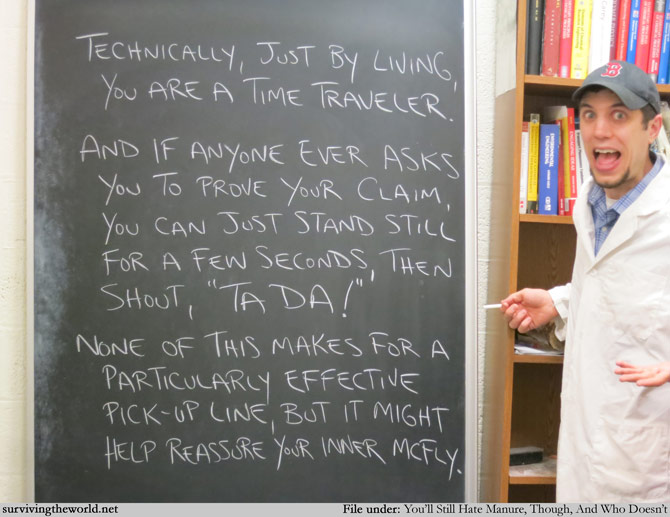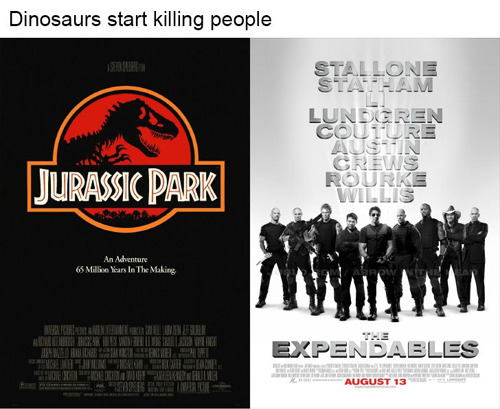Evelyn is hosting AW # 57, Seeing Geology Everywhere.
I see rocks. They're everywhere, in everything. And most of the time, people don't even know they're rocks.
This is a topic I've brought up more times than I can count at this point. (See "Show Me Your Sidewalk," "Geology is All Around Us!" "Geology at Oregon State University," "AW #52: Geology Dream Course," "The Geo Biz," "We Dohn' Need No Steenkin' Rocks," "98 102 97 88" "Cycles Without End (AW #30)," and, in particular, "A Worldview That Resonates With Me," as a few selected examples.) The question I keep getting stuck on is, "What can I say that I haven't said before?"
The only thing I can think of is to phrase it as a challenge: I defy you to find *anything* in your environment that isn't directly or immediately indirectly (by which I mean only one or two steps of remove) dependent upon, or shaped by, geological resources and processes. The thing is, there really isn't anything that doesn't fit that description. The landscape you live in (or vacation in, for that matter), however modified by human engineering, was created in its basic outlines by water, the solid earth, climate and biological interactions. The computer you're reading this on is a creation of a wide variety of minerals and petrochemicals, painstakingly fabricated, doped with extraordinary precision, and despite its incredible complexity, assembled and sold at a price people can readily afford. Almost everything in your home was delivered by (mainly) steel vehicles propelled by hydrocarbon combustion. It's a rare meal indeed, at least in the developed world, that doesn't have a healthy (or unhealthy) dose of table salt, NaCl, or halite. For the sodium sensitive, you can substitute in a certain amount of KCl, or sylvite. If you get heartburn after a hearty meal, you can take an antacid made of fine-grained calcite, CaCO3, or gibbsite, aluminum hydroxide, Al(OH)3, to neutralize the acid. Then you can relax with a glossy magazine or coffee table book. The reason the pages are glossy is that a mixture of clay minerals has been rolled and compressed into the paper; the tiny clay flakes are flattened parallel to each other, giving the paper the appearance of reflectivity. It's the man-made equivalent of phyllite.
Geology's ubiquity and importance in terms of materials and energy make it among the most economically important of the sciences. The fact that so few people seem to get that is frustrating. I am by no means arguing that everyone should be an expert in geology, but I would argue that nearly everyone would benefit by having a good high school-level, year-long, geology course. What rightly or wrongly is perceived as a recent spate of billion-dollar disasters have been in large part geologically mediated. It doesn't require a college degree to be able to pick out settings that are more or less susceptible to flooding, storm surges, wind damage, landslides, slumps, debris flows/lahars, tsunamis, earthquake damage and so on. In many cases, a minimum of education, rather than waiting for the intonations of experts, could help an intelligent consumer make better choices about places that are more or less safe to live.
And I haven't even touched (here) on the awe and amazement I feel when, with the help of both what I know, and research performed by others, I stand on an outcrop, and gaze clearly into the past, through an abyss that might measure billions of years in duration. I have felt nothing, and I mean absolutely nothing, that makes me feel one with creation, in the way that experience does.
So, yes. I see rocks. They're everywhere. Most people don't even know they're rocks. And from my perspective, that's an enormous loss on their part.
Miscellaneous thoughts on politics, people, math, science and other cool (if sometimes frustrating) stuff from somewhere near my favorite coffee shop.
Saturday, June 15, 2013
Geo 365: June 15, Day 166: WOA, Indeed!
Dana takes advantage of one of the benches on the trail on the Big Obsidian Flow to read an interpretive sign. Paulina Lake in the distance, and if you enlarge the photo to full size, you'll be able to see Mount Bachelor and South Sister on the middle horizon. Here's a shot of the sign:
Photos unmodified. August 21, 2011. FlashEarth location.
Photos unmodified. August 21, 2011. FlashEarth location.
Friday, June 14, 2013
Geo 365: June 14, Day 165: Solitary Sapling
Yet another one of those astonishing pines... you walk by, and wonder how in heaven and earth these things hang on with absolutely nothing going for them. It's tempting to flip over a boulder or two to see if there's *any* soil in their root zone at all. Of course, that would almost certainly be fatal for the tree, so the temptation is passing. In the end, I can't help but being awed and deeply respectful for an organism that can survive such a terribly hostile habitat.
Photo unmodified. August 21, 2011. FlashEarth location.
Photo unmodified. August 21, 2011. FlashEarth location.
Thursday, June 13, 2013
Geo 365: June 13, Day 164: Stunted Pine
More or less at the high point of the loop trail on the Big Obsidian Flow, there's a bench with a nice view to the south and east, and a wee bit of shade from this stunted pine. Given the size of the bench, in the lower middle, I'd guess the tree is maybe 12-15 feet high, but look how disproportionally thick its trunk is! Also, look at how many of the upper branches have died. As I indicated yesterday, this very much an outcome of the geological setting: soils have not had a chance to develop, which means moisture and nutrients are fleeting and nearly unavailable. Rather than creating a mutually protective and nurturing forest environment, individual trees stand starkly alone and unsheltered. Trees in nearby areas, areas that are climatologically identical, for all practical purposes, but with older, more weathered substrates, create large, healthy stands. Up here on the broken glass, every winter and every summer are a touch-and-go struggle for existence.
But these pioneers contribute to soil development, physically and chemically weathering the bedrock. In their annual shedding of needles, bits of bark and deadwood, and eventually through their own deaths, they contribute organic material- which means nutrients and better water retention. It's sort of mind boggling to imagine this as a snapshot of one year in a few tens of millenia- at the end of which the entire surface of this flow will be obscured under a forest and its duff. A setting in which only the geologically-minded will notice the bits of oddly dark, glassy rock peaking from under the forest litter.
Photo unmodified. August 21, 2011. FlashEarth location.
But these pioneers contribute to soil development, physically and chemically weathering the bedrock. In their annual shedding of needles, bits of bark and deadwood, and eventually through their own deaths, they contribute organic material- which means nutrients and better water retention. It's sort of mind boggling to imagine this as a snapshot of one year in a few tens of millenia- at the end of which the entire surface of this flow will be obscured under a forest and its duff. A setting in which only the geologically-minded will notice the bits of oddly dark, glassy rock peaking from under the forest litter.
Photo unmodified. August 21, 2011. FlashEarth location.
Wednesday, June 12, 2013
Geo 365: June 12, Day 163: Bonsai
A frequent Interzone visitor asked me to post a couple shots of the stunted trees on the Big Obsidian flow. My pleasure! Paulina Peak in the distance, a ridge of obsidian boulders in the foreground. The fact that trees have been able to colonize this surface at all is nothing less than astonishing. There is no soil to speak of, and water drains out and through almost instantly. During the summer, the dark rock absorbs the intense sunlight, raising the temperature well above the surrounding woodlands; during the winter, the bare rock does nothing to blunt the cutting wind and snowblasting. I think these are lodgepole pines, but whatever they are, their tenacity is breath taking.
Photo unmodified. August 21, 2011. FlashEarth location.
Photo unmodified. August 21, 2011. FlashEarth location.
Tuesday, June 11, 2013
Geo 365: June 11, Day 162: Folded Foam
One last bit of seriously folded pumiceous obsidian. I had never made the connection before going through these photos, but does seem as if the frothy phase of this lava flow is more prone to this sort of deformation. On one hand, this makes a bit of sense: gas pockets would be easier to deform than high-silica lava. On the other, vitreous zones don't have the contrast these do, and may be folded, but not as visibly. And it seems questionable to think that a sample based on selected photos necessarily represents a realistic cross section of the actual features on the flow. In the end, I'll say the frothy component appears more likely to be folded, but it's something I should consciously look for (as opposed to notice in retrospect) next time I visit.
Photo unmodified. August 21, 2011. FlashEarth location.
Photo unmodified. August 21, 2011. FlashEarth location.
Monday, June 10, 2013
Geo 365: June 10, Day 161: Flow Breccia
Three distinct pumiceous blocks have apparently been welded together to form a single boulder. I can't think what else this would be called but a breccia.
Photo unmodified. August 21, 2011. FlashEarth location.
Photo unmodified. August 21, 2011. FlashEarth location.
Sunday, June 9, 2013
Sunday Funnies: Adulthood Edition
What Would Jack Do?
Clay Bennett
Bizarro
Tastefully Offensive
Surviving the World
Pinterest
Mark Stivers
What Would Jack Do?
Tastefully Offensive
Two of nineteen "realistic slogans" at Buzzfeed.
"Bookseller humor" You Rach You Lose
Funny to Me
"Movies that can be described with the same sentence." (one of five pairs) Tastefully Offensive
@jimmyfallon
Clay Bennett
"At the end of a lecture on Theoretical Planetary Geophysics where I only understood every other word" Geology is Hard
Senor Gif
LA Times
Senor Gif
Tastefully Offensive
Tastefully Offensive
Bizarro
Bits and Pieces
"When students want me to change the grade I gave them" What Should We Call Grad School?
Funny to Me
Blackadder
Clay Bennett
Bizarro
Tastefully Offensive
Surviving the World
Mark Stivers
What Would Jack Do?
Tastefully Offensive
"Bookseller humor" You Rach You Lose
Funny to Me
"Movies that can be described with the same sentence." (one of five pairs) Tastefully Offensive
@jimmyfallon
Clay Bennett
"At the end of a lecture on Theoretical Planetary Geophysics where I only understood every other word" Geology is Hard
Senor Gif
LA Times
Senor Gif
Tastefully Offensive
Tastefully Offensive
Bizarro
Bits and Pieces
"When students want me to change the grade I gave them" What Should We Call Grad School?
Funny to Me
Blackadder
Geo 365: June 9, Day 160: Glassy Taffy
More deformed flow banding in the Big Obsidian Dome at Newberry Volcano National Monument, Oregon. The title on this one amused me, but it is a little cringe-inducing. I suspect the above might not be the finest confectionery experience, but more like something out of a Monty Python sketch.
Photo unmodified. August 21, 2011. FlashEarth location.
Photo unmodified. August 21, 2011. FlashEarth location.
1,500,000
Here was the overview of my visitation stats as of yesterday evening, right before I left:
And here is the same plot as of this morning:
A bit over 5 years, a few over 3000 posts, and now over 1.5 million page views. This has definitely been a season of milestones!
And here is the same plot as of this morning:
A bit over 5 years, a few over 3000 posts, and now over 1.5 million page views. This has definitely been a season of milestones!


































